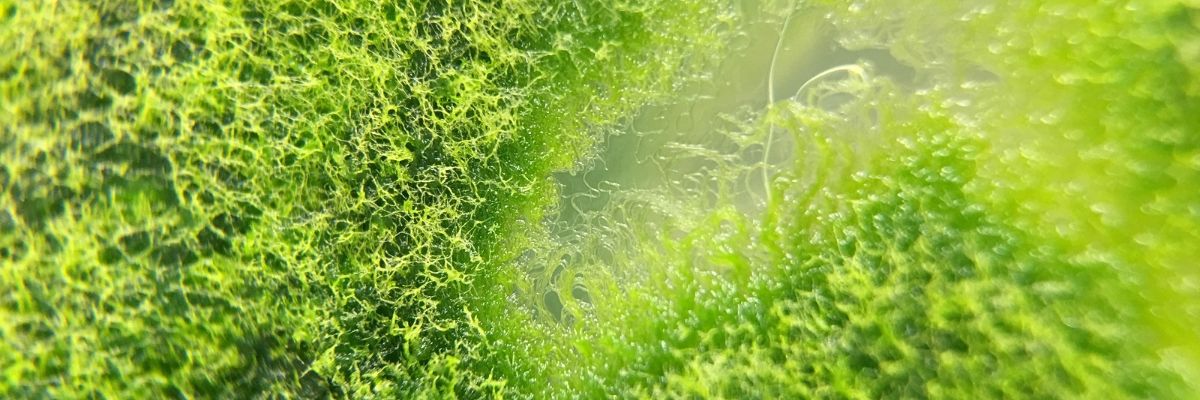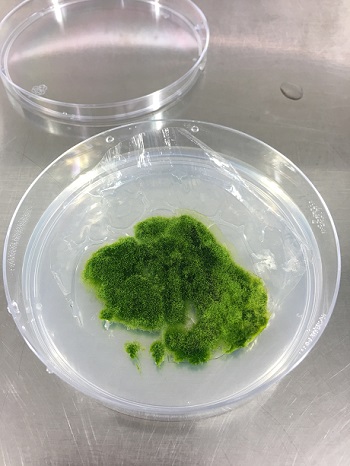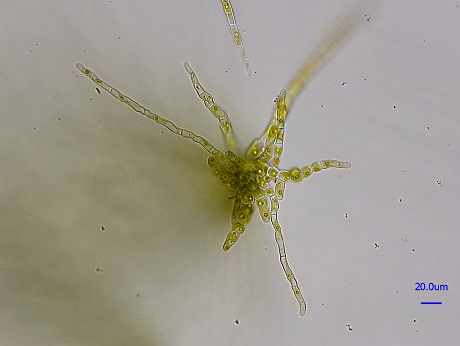
Newly discovered alga could help unlock the secrets of plant evolution
20. 01. 2025
Draparnaldia erecta – that’s the name of a multicellular green alga that Lenka Caisová from the Biology Center of the CAS happened upon during her vacation in Sardinia. This previously unknown plant immediately captured the scientist’s attention, leading her to begin an in-depth investigation. She quickly recognized its potential. According to Caisová, this alga could help answer fundamental questions in evolutionary research, such as how plants transitioned from aquatic to terrestrial environments. The significance of the discovery has been acknowledged by the German Society for Plant Scientists, which declared Draparnaldia erecta “Alga of the Year” for 2025.
At first glance, it looked like moss. However, Caisová, from the Institute of Plant Molecular Biology at the Biology Center of the CAS, noticed something unusual about the unassuming plant amid Sardinia’s natural surroundings. Back in the lab, she realized she had stumbled upon a true gem.
“I discovered that it is a previously unknown green alga with unique adaptations to both aquatic and terrestrial habitats – adaptations that can be induced in laboratory conditions. This makes it an ideal organism for studying how algae transitioned from water to land or how multicellularity evolved,” the scientist explains.

At first glance, the alga Draparnaldia erecta resembles moss.
Draparnaldia also has highly practical qualities for research: it is easy to cultivate, grows very quickly, and completes its life cycle in just seven to nine days. It reproduces via zoospores (unicellular stages), which can be produced en masse – an essential feature for conducting experiments focusing on multicellularity. “Our goal is to establish Draparnaldia as a model organism for basic research. In addition to developing protocols for its lab cultivation, we have already detailed its morphology, development, and adaptations to aquatic and terrestrial habitats. We have also mapped its phytohormones and sequenced its genome,” Caisová explains.
Not all algae are the same
Green algae are divided into two groups: chlorophytes and streptophytes. Both groups independently evolved multicellularity and often inhabit similar habitats. However, only streptophytic algae managed to transition from water to land – a process known as plant terrestrialization – and to diversify into the thousands of terrestrial plant species we know today. Scientists have long sought to decipher why it was only streptophytes that succeeded in transitioning to land and not chlorophytes as well.
The study of multicellularity and terrestrialization in green plants has traditionally relied on morphologically complex model organisms, such as Marchantia, Physcomitrium, and Arabidopsis. More recently, streptophytic algae, the direct ancestors of land plants, have joined this model pool – examples include Klebsormidium, Chara, and Zygnema. However, there has so far been no model organism among chlorophytes that both resembles early land plants morphologically and has adaptations to live on land. Draparnaldia is closing this gap.
“Draparnaldia is unique, as it is the only chlorophyte that has developed morphological complexity comparable to that of early land plants. It has a branched apical cellular system resembling a small land plant and long cells that resemble a root system,” Caisová describes.

The root-like structures of the alga Draparnaldia erecta under a microscope.
These cells grow downward in aquatic environments. However, upon transitioning to land, the entire plant essentially upends itself, with its “roots” suddenly growing upward. This distinctive characteristic inspired the species name erecta.
Insights from Draparnaldia
How did unicellular algae evolve into multicellular organisms, and how did they colonize land? According to researchers, these are the questions Draparnaldia – found, incidentally, in the Czech Republic as well – might help answer. Despite evolving independently for over a billion years, this inconspicuous alga exhibits remarkable parallels to the terrestrialization processes observed in streptophytic algae and land plants. It has, however, developed alternative mechanisms of hormonal signaling, the study of which could provide vital insights into how plants transitioned from water to land. It may also shed light on the functions of plant hormones.
“If everything goes well, we could achieve significant research results within two years that could contribute to understanding plant evolution,” says Caisová, Head of the Plant Terrestrialization Lab at the Institute of Plant Molecular Biology, Biology Centre of the CAS.
Learn more about Draparnaldia research from Lenka Caisová in the following video (turn on CC for English subtitles):
Written by: Radka Římanová, External Relations Division, CAO of the CAS, drawing on the Biology Center of the CAS press release (in Czech)
Translated and prepared by: Tereza Novická, External Relations Division, CAO of the CAS
Photo: Lenka Caisová’s archive; Biology Center of the CAS
 The text is released for use under a Creative Commons license.
The text is released for use under a Creative Commons license.
Read also
- A trapped state: The pandemic impact on public attitudes, trust, and behavior
- Aerial archaeology: Tracing the footsteps of our ancestors from the sky
- Archaeologists uncover ancient finds along Prague Ring Road
- Our microbiome largely depends on what we eat, says microbiologist Michal Kraus
- The ABCs of writing: Why did its invention mark a turning point for humankind?
- We learn, remember, forget… What can memory actually do? And can we outsmart it?
- New Center for Electron Microscopy in Brno opens its doors to global science
- The hidden lives of waste: What can we learn from waste workers and pickers?
- A unique lab is hidden right beneath Prague’s Vítkov Hill
- Renewables are a strategic investment in European security, scientists say
The Czech Academy of Sciences (the CAS)
The mission of the CAS
The primary mission of the CAS is to conduct research in a broad spectrum of natural, technical and social sciences as well as humanities. This research aims to advance progress of scientific knowledge at the international level, considering, however, the specific needs of the Czech society and the national culture.
President of the CAS
Prof. Eva Zažímalová has started her second term of office in May 2021. She is a respected scientist, and a Professor of Plant Anatomy and Physiology.
She is also a part of GCSA of the EU.